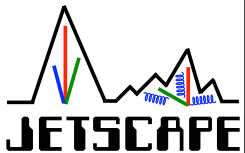THERE ARE TWO PARTS TO THESE INSTRUCTIONS, "JETSCAPE FRAMEWORK" AND "STATISTICAL ANALYSIS".
IN ORDER TO BE WELL PREPARED FOR THE HANDS ON SESSIONS DURING THE SCHOOL PLEASE WORK THROUGH BOTH PARTS.
THE HANDS ON SESSIONS ARE BYOB: "BRING YOUR OWN DEVICE".
School Preparation - JETSCAPE Framework
Please install the public JETSCAPE Framework prior to the first school working session to enable an efficient start. If you have any questions or encounter any problems, please contact Chun Shen (chunshen@wayne.edu).
Prerequisites:
-
C++ Compiler with C++11 support (GNU C compiler 7 or above)
-
CMake version 3 and above
-
GSL library (https://www.gnu.org/software/gsl/)
-
PYTHIA 8 (http://home.thep.lu.se/Pythia/)
-
Boost (https://www.boost.org)
-
zlib (should be already installed)
-
Jupyter notebook (https://www.anaconda.com)
-
ROOT 6 (https://root.cern.ch)
Instructions to install above required libraries can be found in the README.md (mac) or README_LINUX.md (for Linux) in the JETSCAPE package.
JETSCAPE package can be download from https://github.com/JETSCAPE/JETSCAPE.
Or in terminal type: git clone https://github.com/JETSCAPE/JETSCAPE.git
Installation instructions for the Prerequisites:
-
Windows: Windows is currently not supported. We recommend you install a virtual machine https://www.storagecraft.com/blog/the-dead-simple-guide-to-installing-a-linux-virtual-machine-on-windows and a recent version of Scientific Linux. Then follow the instructions for Linux.
-
Apple Mac:
Install a recent version of Xcode from the App Store; it should provide clang version 3.3 or above.
Install the command line tools: Open a Terminal and enter (without the "%")
% xcode-select --install
Install Homebrew.
Install GSL: Open a Terminal and enter (without the "%")
% brew install gsl
Install cmake: Open a Terminal and enter (without the "%")
% brew install cmake
Install boost: Open a Terminal and enter (without the "%")
% brew install boost
If necessary, install zlib: Open a Terminal and enter (without the "%")
% brew install zlib
-
Linux:
Note: It is assumed that you have administrator permissions or can obtain them using sudo. If that is not the case, please contact your System Adminstrator.
Ensure gcc version 7 or above: In the command line, enter (without the "%")
% gcc --version
If the version is too low, please update to the required version
If necessary, install cmake using your distribution's package manager. In this example we assume yum, but it can be replaced by apt-get or port as appropriate:
In the command line, enter (without the "%")
% sudo yum install cmake
If the version is too low, please update to the required version
If necessary, install zlib: In the command line, enter (without the "%")
% sudo yum install zlib
The third session of the workshop will focus on an "analysis" of JETSCAPE output. For histogramming and visualization, we recommend ROOT v. 6, an existing version of which will be picked up during installation. It can be installed with package managers in the same manner as the required dependencies, i.e.
% brew install root
or
% sudo yum install root
Note: Please make us (chunshen@wayne.edu) aware of any other packages you would like to use instead.
Installation of the Framework:
Download the source: In the command line, navigate to the directory where you want to install, and enter (without the "%"):
% git clone https://github.com/JETSCAPE/JETSCAPE
% cd JETSCAPE
% mkdir build
% cd build
% cmake ../
% make
Test with the following commands which should produce an output file named test_out.dat:
% ./brickTest
% ./readerTest
To compile the JETSCAPE framework with a hydrodynamic module (MUSIC), first go to JETSCAPE/external_packages/
% cd JETSCAPE/external_packages/
% ./get_music.sh
Then go back to the build folder,
% cd ../build
% cmake .. -Dmusic=ON
% make
A test executable MUSIC_evo will be generated once the compilation is completed.
% ./MUSIC_evo
To generate plots for the final results, we will use jupyter notebook. Please install it on your computer. If you don’t have any experience with python, you can install all the needed packages through anaconda, https://www.anaconda.com
We encourage all attendants to familiarize themselves with the code and experiment with it!
School preparation - Statistical Analysis
- Install Miniconda for Python 3.6 by following the Regular Installation instructions: https://conda.io/docs/user-guide/install/index.html.
- If you don't have R, download R from https://cran.cnr.berkeley.edu/.
- Open an R Console instance by opening the R app or by typing R in the command line.
- In the R console, type the command install.packages(`lhs') and pick an appropriate download mirror if prompted. To ensure the package was properly installed, type library(lhs) in the R console. If that command runs without error, the package is installed. Close the R console.
- In a folder you can access, clone the git repository by `git clone -b WS2018 https://github.com/keweiyao/hic-param-est-2017`. It contain both the software and the slides for the session.
- Open Terminal (OSX, Linux) or Windows Command Prompt (Windows).
- Navigate to the downloaded/cloned git repository.
- Type: conda create -n hic-param-est numpy h5py scikit-learn pyyaml jupyter matplotlib pathlib pandas python=3.6. This line creates a Python 3 environment called `hic-param-est' and downloads some necessary packages.
- Type: source activate hic-param-est. This switches you into your newly created environment.
- Type: pip install emcee hic.. This installs some more packages that are unavailable through conda.
- Type: jupyter notebook. This will open Jupyter iPython Notebook in a web browser.
- In Jupyter, open WinterSchoolQuestions.ipynb , and run the first cell. If it runs without error, then you should be properly set up for the program.
- For participants without experience on scientific computing with Python. We encourage to take a look at the SciPy Lecture Notes at https://www.scipy-lectures.org/, especially section 1.3 NumPy and 1.4 Matplotlib for array manipulations and plotting functions.

